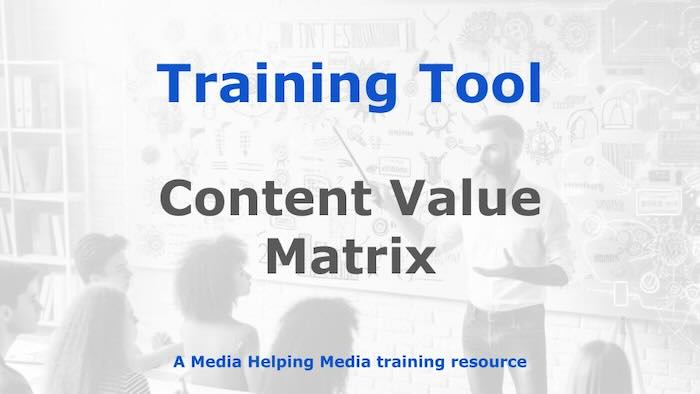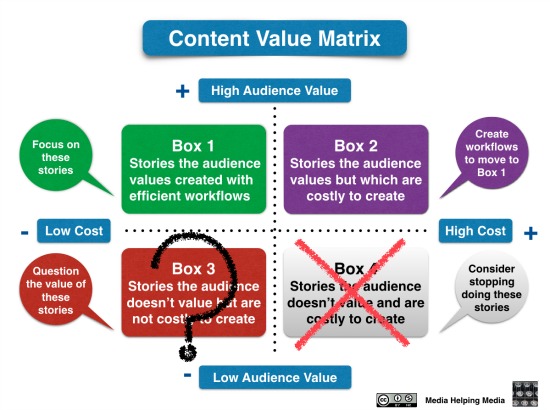 In this article we look at the ‘content value matrix, a tool designed to help media managers prioritise effort and resources on the stories that really matter to the target audience.
In this article we look at the ‘content value matrix, a tool designed to help media managers prioritise effort and resources on the stories that really matter to the target audience.
There are many demands on a newsroom. There is the routine flow of news releases and stage-managed events that need to be covered. There are the stories from the various wires services. There are the unexpected breaking and developing news stories. There are the original stories which journalists stumble across in the course of their work.
And there are well-planned, in-depth reports, produced by reporters investigating issues and uncovering previously unpublicised information.
By using the ‘content value matrix’ media managers will find that resources, previously allocated to stories of little interest to the audience, can be saved and reinvested stories that matter.
The content value matrix
Running a modern, converged news operation, delivering content to multiple devices, 24 hours a day, is like being on a treadmill; there is so much to do that editors sometimes find it hard to stop and take a hard look at the material being produced.
That is why a content review is required from time to time to ensure that journalists are being deployed strategically, and that the work they are doing is meeting the information needs of the target audience.

The content value matrix is a tool developed by Media Helping Media and used in the course of media strategy work for more than 20 years.
It is designed to help media managers focus resources on the stories that matter, and it will help them drop – or reconsider – the stories that the audience doesn’t find interesting.
Essential data
Before you start you will need to gather some data. This can be from audience research, or it can be from analysing the visits to your online and mobile material.
Use this data to find out which stories the audience values the most. Then plot the stories in a graph.
Draw a vertical line on a white board. This is your cost line. At the top put a plus sign and at the bottom a minus sign. Now draw a horizontal line through the middle. This is your audience appreciation line.
On the left put a minus sign, and at the right put a plus sign. Now enter the stories as a scatter chart.
Box 1 – high audience value, low production costs
-
- Stories in the top left quadrant, Box 1, are stories that the audience values, and which are not costly to produce.
- These are the stories on which you should focus.
- The more you do of these stories, the more the audience will appreciate your news service, and the more efficient you will be.
- The challenge you face is to remain focussed on these stories and avoid being distracted by trivial news that has no real value to your audience or to your business.
Box 2 – high audience value, high production costs
-
- Stories in the top right quadrant, Box 2, are stories that the audience values, but which are costly to create.
- The challenge for you as a media manager is to move these stories into the top left quadrant, Box 1, so that they remain stories the audience values, but they are not costly to produce.
- This will mean you will need to introduce more efficient workflows. Introducing a converged newsroom will help you achieve this.
Box 3 – low audience value, low production costs
-
- Now let’s look at the bottom left quadrant, Box 3.
- You will notice that these stories are not costly to produce but, so far, have not been valued by the audience.
- Stories in this quadrant deserve some analysis.
- It could be that these stories are important in terms of informing the public debate, but your journalists haven’t been telling them properly, or haven’t been producing them in a compelling way.
- Take some time to consider how these stories can be moved into Box 1.
- It could be that some in-house training is needed in how to write scripts, use images or interview people.
- It could be as simple as organising training in better headline writing.
- This might not be a time-consuming task, but the more of these stories you can move to Box 1 the better.
Box 4 – low audience value, high production costs
-
- Now let’s look at all the stories that fall into Box 4.
- These are stories that are costly to produce and which the audience doesn’t value.
- This is the easiest decision to make.
- Simply stop doing these stories and, instead, transfer resources to the other three boxes.
The aim of the content value matrix
- Carry out this exercise at least once a year; preferably every six months.
- It will help you evaluate what you are producing, how you are producing it, how you promote it, and whether it still meets the needs of your target audience – on which your entire news business logic is built.
Strengths and benefits:
- Strategic resource allocation: Helps prioritise efforts and resources on high-value stories.
- Improved audience engagement: Focuses on content that resonates with the target audience.
- Increased efficiency: Reduces wasted resources on low-value, high-cost stories.
- Data-driven decision making: Relies on audience research and analytics.
- Content optimisation: Encourages improvement in storytelling and presentation.
- Regular evaluation: Promotes periodic reviews to ensure content remains relevant.
- Adaptability: Helps news organizations adapt to changing audience needs and preferences.
- Financial benefit: by reducing cost, and increasing audience engagement, the overall financial health of the news organisation should improve.
Story weighting
The content value matrix tool should be run in conjunction with another tool developed by Media Helping Media – the story weighting system. Read more about how to apply this model in order to assess the value of stories when creating a running order or list of story priorities.








